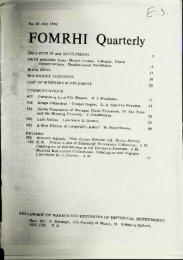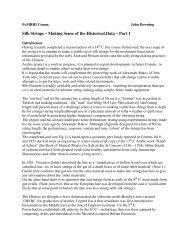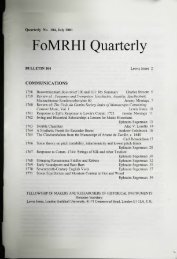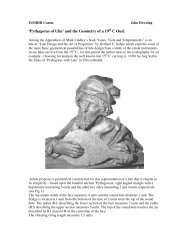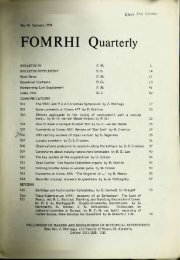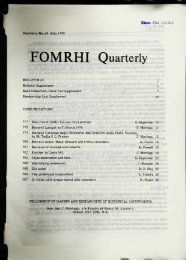•rf - FoMRHI
•rf - FoMRHI
•rf - FoMRHI
You also want an ePaper? Increase the reach of your titles
YUMPU automatically turns print PDFs into web optimized ePapers that Google loves.
Horniman wind instruments, p.6<br />
p.lOO continued<br />
Saxhorn, Boosey. Thia is a Koenig Horn, and it has three crooks<br />
and compensating pistons.<br />
Bugie, Carse 56B. This is a Boy's Bugie, pitched in the usuai<br />
B fiat but with small bore to make it less effort to<br />
blow.<br />
I hope that these details may be of use, now that the Carse Catalorrue<br />
is out of print. Morley Pegge gave me more detail on the brass than<br />
on the woodwind. Perhaps another <strong>FoMRHI</strong> member can give us more detail<br />
cf the woodwinds. ìt may be worth saying again that as well as the<br />
handbook, the plates can be bought as a separate little folder, casting<br />
only 15p-> so that if you know anycne working as a student of wind<br />
instruments, there are ampie illustrations available very cheaply<br />
(where else can you buy 92 photographs for 15p.?) to illustrate any<br />
written work.<br />
FURTHER ON COMMUNICATION 29<br />
E Segerman and D Abbott<br />
Comm. 29 has aroused some discussion amongst lute makers, especially at the<br />
annual informai get-together at the Lute Society Summer School. We talked to<br />
people who have seen many more rarly lutps than we have. and as a result some<br />
points need modifieation.<br />
C 1. The end elasp can be thinner than the ribs so that it can more easily bend<br />
around the compound curve. On the inside, opposite it, with about the same<br />
width, somewhat shorter in length and up to 3 times its thickness, is an<br />
inside clasp called 'fausse' or 'contrebragne' by Mersenne. These two clasps<br />
sandwich the ends of the ribs which, according to Hellwig's X~rays, can<br />
often be rather broken-off inside. * *<br />
C 7.The neck block cutaway is not as common on originai instruments as we<br />
thought. This is a pity since the acoustic and repair advantages with no<br />
strength disadvantages are so obvious.<br />
Several points need to be emphasized with respect to Comm. 29. We attempted to<br />
indicate what we hoped were typical parameters of early lutes. The proper research<br />
assembling ali of the data possible so as to try to determine what is typical (and<br />
what were significant variants from typical) at each time and place has not yet been<br />
done. As we said, some was just guesswork based on relatively little data. For<br />
instance the suggestion in C 13 to increase the rib thickness to 2 mm. is based only<br />
on an originai mid~16th century lute back in our possession which has sycamore<br />
ribs 1.8 - 2.5 mm. thick Mersenne (1636) said 2.5 mm. We have since been told<br />
by an authority that most of the lutes he has restored had ribs closer to lmm. in<br />
thickness.<br />
We hope that there was no implication read into Comm. 29 Section C that Philip<br />
McCleod Coupé agreed with ali of our suggested modifications. Until the proper<br />
research is done (and perhaps even after, if the data cannot resolve issues) it is<br />
appropriate that there be friendly differences of opinion.<br />
-4«-





